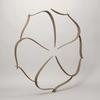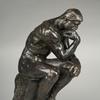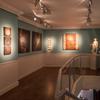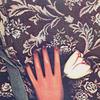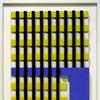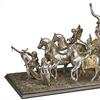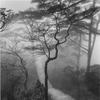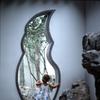Exhibition to Reveal Abstract Painter Frederick Hammersley's Unique Creative Process, Meticulously Outlined in Personal Archives
- SAN MARINO, California
- /
- July 20, 2017
A fall exhibition at The Huntington Library, Art Collections, and Botanical Gardens on the American abstract artist Frederick Hammersley (1919-2009) showcases his sketchbooks, notebooks, inventories, and vibrant color swatches to illuminate the painstaking process the artist used to create his hard-edge geometric paintings. “Frederick Hammersley: To Paint without Thinking” is on view in the Susan and Stephen Chandler Wing of The Huntington’s Virginia Steele Scott Galleries of American Art from Oct. 21, 2017 to Jan. 22, 2018.
To accompany the exhibition, The Huntington is publishing a fully illustrated catalog with several scholarly essays revealing new research on the topic.
“Frederick Hammersley: To Paint without Thinking” features about 50 objects pairing items from Hammersley’s archives (a recent gift to the Getty Research Institute) with five paintings, including The Huntington’s See saw (1966), and dozens of other works, including lithographs, silkscreens, and works of digital art from the collections of The Huntington, the Los Angeles County Museum of Art, New Mexico Museum of Art, Palm Springs Art Museum, and Santa Barbara Museum of Art.
Highlights of the Hammersley archives include his notebooks and sketchbooks, in which the artist developed compositions over a period of decades. In these books, he generally used a two-stage process, first composing postage stamp-sized images—sketched out in pencil, colored pencil, or ballpoint pen—then selecting some compositions for sizing up to a larger scale, sometimes in oil paint. “These sketchbooks served as a forum for exploration and a wellspring from which he drew throughout his long career,” said James Glisson, Bradford and Christine Mishler Associate Curator of American Art at The Huntington and co-curator of the exhibition. “It is like peeking over his shoulder to see him at work, altering a color or two, adding or subtracting a line, then moving on.” In the exhibition, pages from Notebook #3 and a composition book give of a sense of how Hammersley might have worked out See saw.
“Painting Books”
Hammersley, who lived in Los Angeles until 1968, entered the spotlight in 1959 as one of the artists in the international exhibition “Four Abstract Classicists.” He was unique among his peers in that the elegant simplicity of his paintings stemmed from a rigorous process of refinement that he tracked in extreme detail. His “Painting Books,” two of which are on view in the exhibition, contain dated entries for every step of the painting process, from stretching a canvas and applying paint to varnishing and touching up. These invaluable records outline the process and materials used in more than 150 of his geometric paintings. Such a level of record-keeping was a boon for exhibition co-curator Alan Phenix, scientist at the Getty Conservation Institute, whose essay in the exhibition catalog unpacks Hammersley’s paintings from the technical perspective. Phenix observes, “I doubt there exists anywhere such a large group of paintings that is so fully described from the material and technical point of view.” For example, Phenix discovered during his research that Hammersley, who nearly always used traditional high-quality artists’ oil paints, occasionally adopted unconventional materials, such as exterior paints made for houses and factories.
Experimental lithographs
“Frederick Hammersley: To Paint without Thinking” puts on display 45 experimental lithographs made in 1949, a pivotal moment when Hammersley had reached an impasse with painting and turned to the exacting medium of stone lithography. He taught himself the complex lithography process, pulling prints on the weekends at Chouinard Art Institute in Los Angeles, where he was teaching. Numbering in the hundreds, these prints each measured 3- by 3-inches, and consisted of a 4-by-4 grid with 16 squares. That is when Hammersley seems to have settled on his lifelong pattern of using self-imposed rules to generate art.
“Hammersley said he wanted ‘to paint without thinking.’ By that he meant that he wanted to limit his options, and by using the grid method, he cut through the bewildering thicket of choices that confronts any artist staring at a blank canvas or sheet of paper figuring out what to do,” said Glisson. “Looking at the geometric paintings he produced from the 1950s through the 1990s, it’s clear Hammersley thrived within these self-imposed constraints.”
“Computer drawings”
In 1968, Hammersley took a break from painting and moved to Albuquerque, New Mexico. Shortly after arriving there, he learned Art1, a computer program written by University of New Mexico faculty and among the first programs designed for visual artists. Using punch cards, a then-state-of-the-art IBM 360/40 computer, and a tractor-fed 1403 IBM line printer, Hammersley made what he called “computer drawings.” Computers were still the province of arcane Cold War research and think tanks, yet Hammersley’s printouts were artistically conceptual and had witty titles. JELLY CENTERS, with its darkened series of ovals, references jelly-filled doughnuts. SLEEPING PILL IT’S NOT has no lozenge shaped pills; rather its pattern of dots form a slightly jarring optical illusion that wouldn’t put anyone to sleep.
Glisson believes that while the computer art interlude did not in any obvious way change how Hammersley’s geometric paintings looked, the ‘Painting Book’ entries became much more detailed. Glisson’s hunch is that the step-by-step recording of the paintings’ creation came out of mastering Art1’s complicated instructions for punching holes in data cards to generate shapes and patterns. “While Hammersley did not view the entries as recipes or instructions, I sometimes do,” said Glisson, “and I can’t help but think of them as having a resemblance to a computer program, which is a set of instructions.” Just as chess and checkers have rules but the rules don’t dictate how a game unfolds and ends, Hammersley’s rules and systems didn’t predetermine the outcome of his work. “For Hammersley, the concept of ‘painting without thinking’ was that grey area between pre-determination and pure chance where he felt unburdened enough to explore and invent,” said Glisson.
Exhibition catalog
To complement the exhibition, The Huntington is publishing Frederick Hammersley: To Paint without Thinking (ISBN 978-0-9986817-1-9), a boldly illustrated catalog edited by James Glisson, Bradford and Christine Mishler Associate Curator of American Art at The Huntington, with contributions from Alan Phenix, scientist at the Getty Conservation Institute, Kathleen Shields, executive director at the Frederick Hammersley Foundation, and Nancy Zastudil, administrative director at the Frederick Hammersley Foundation. Distributed internationally by DAP and retailing for $35, the catalog has 120 pages and 75 illustrations. Available at thehuntingtonstore.org.



